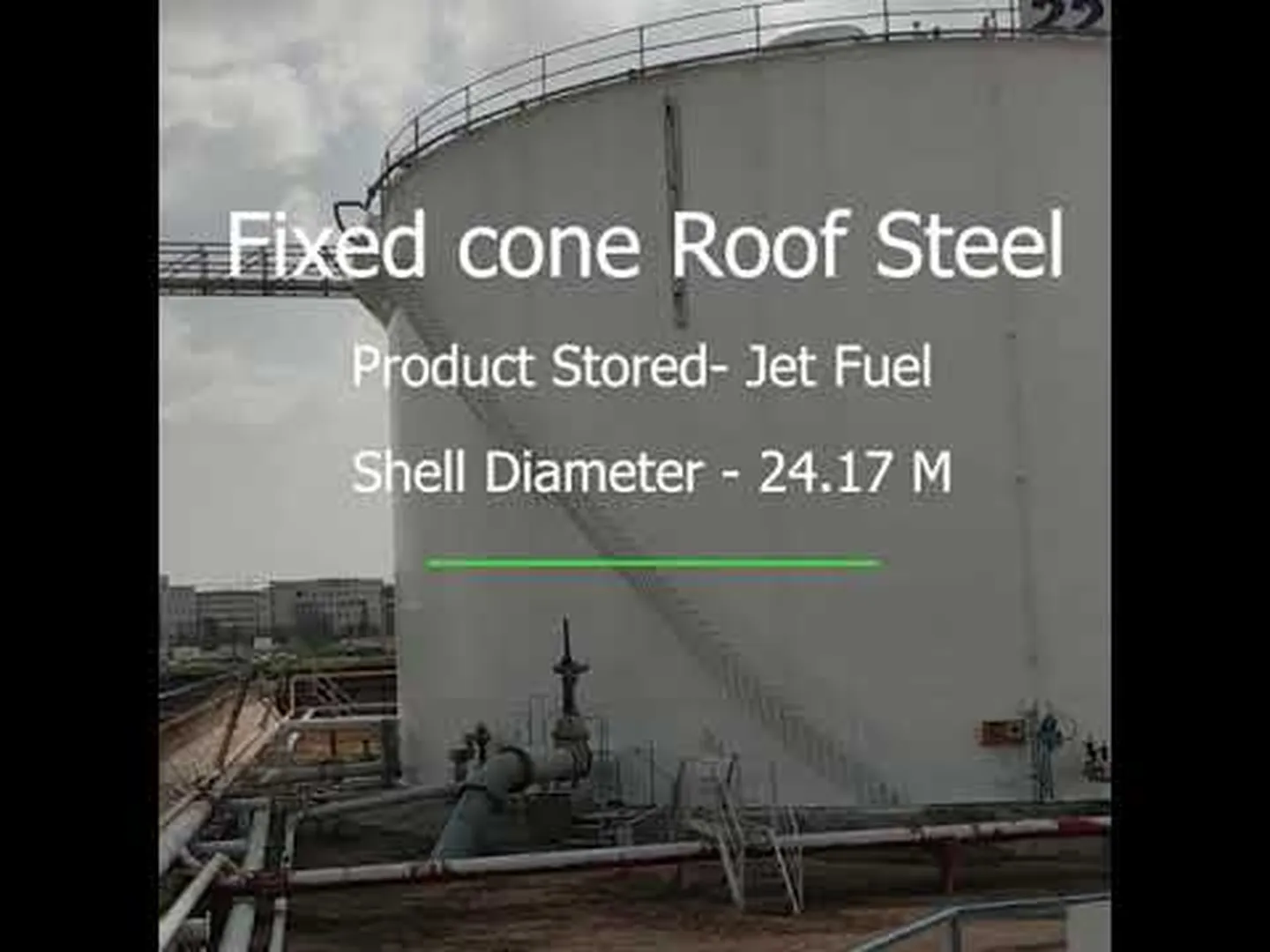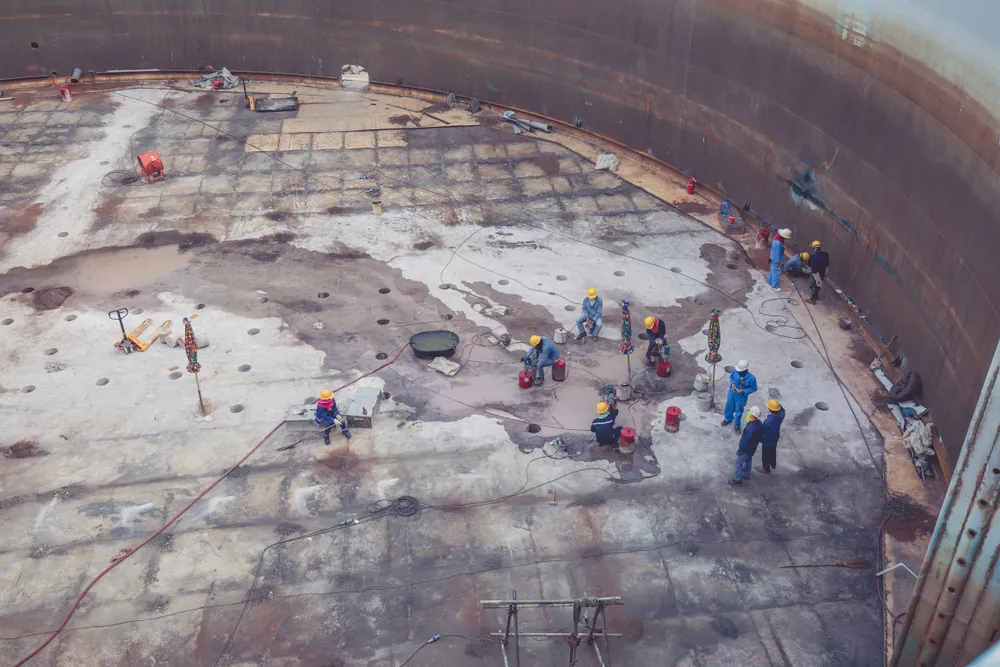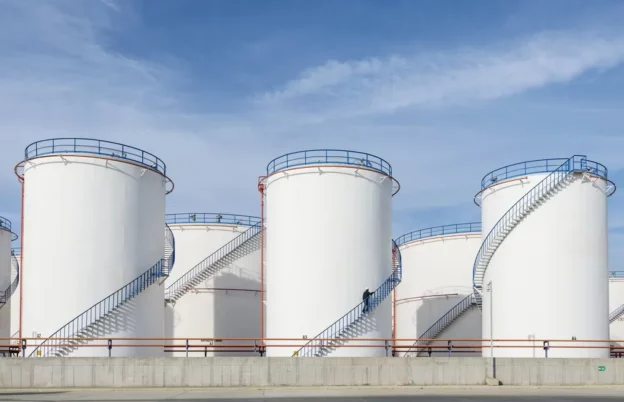Table of Contents
- Introduction
- What is API 653?
- Mechanical integrity of storage tanks
- Evaluation framework for tanks under API 653 standard
- Storage tank inspection according to API 653
- Repair of storage tanks according to API 653
- Risks and consequences of not maintaining tank integrity
- API 653 Certification
- Conclusion
- References
Introduction
Storage tanks are necessary equipment in the industry to contain or preserve various products, from fuels, chemicals to water. Guaranteeing the integrity of these containers through the requirements of API 653 is an essential standard for the continuity of operations, maintaining the supply and marketing chain and avoiding failures that could cause accidents affecting the safety of personnel and the environment.
Compliance with this standard by organizations helps maintain the structural integrity of storage tanks so that they operate within established safety margins, ensuring continued operational activity, minimizing risk and strengthening confidence in asset management practices.
What is API 653?
API 653, a standard established by the American Petroleum Institute, covers carbon steel storage tanks constructed in accordance with API 650 and its predecessor API 12C, and provides the basic requirements for maintaining the integrity of this equipment after commissioning and covers inspection, repair, alteration and rebuilding.
This standard provides a framework of regulations to ensure tank integrity by establishing criteria, specifying procedures, promoting specialized training and implementing a framework for integrity management.
Its scope is limited to the civil foundations or foundations, the bottom or floor, the body or hull, the roof and the supporting structure, the elements or accessories fixed to the tank and the connection nozzles up to the face of the first flange, threaded joint or welded joint. It focuses on evaluating the following aspects: corrosion, mechanical damage, manufacturing defects, leaks, settlements, deformations and environmental conditions. In order to maintain safety, prevent failures and protect the environment.
Mechanical integrity of storage tanks
It is defined as the adequate condition of the tank to safely contain the stored product during its useful life, resisting the forces, pressures, and operational and atmospheric conditions to which it is subjected. This capability is based on the absence of defects that could compromise the structural strength of the tank, such as corrosion, mechanical damage or leaks; therefore, ensuring the mechanical integrity of storage tanks lies in preventing risks associated with their deterioration.
It is easy to understand the importance of maintaining mechanical integrity and operational reliability, because any loss of containment of stored product would result in a severe process and operational safety incident. For these reasons, it is essential to know the typical corrosion mechanisms present and the different failure modes of the main equipment components in order to identify any problems and address them efficiently to maintain integrity.
Evaluation framework for tanks under API 653 standard
The main purposes covered by this standard for maintaining the integrity of storage tanks in service are as follows:
- Repair or maintenance: Means any necessary maintenance or repair work for the purpose of maintaining the integrity of the tank and its safe operation. The remaining examples of repairs include: Removal and replacement of bottom, wall or roof material, installation or replacement of gusset plates, and application of cleaning and painting.
- Alteration: Refers to any work on a storage tank that changes its physical dimensions or original design configuration. Examples: Increasing or decreasing the height of a tank cylinder or replacing the bottom.
- Reconstruction: Any work required to assemble a storage tank that has been dismantled from its original location for removal and relocation to a new site.
- Inspection: The standard recommends several guidelines for the different types of inspections to be performed, while the tank is in operation or out of service for maintenance. These inspections must be supervised by an authorized inspector.
Storage tank inspection according to API 653
API 653 establishes inspection procedures for storage tanks that include evaluation of their condition by reviewing historical and current records, external in-service inspections to identify structural problems such as corrosion, deformation and indications of leaks; and detailed internal inspections after emptying and cleaning the tank for maintenance or repair.
This standard classifies the inspection of storage tanks as: routine, which are performed by custodian personnel knowledgeable of the operations; external or regular inspections, which are performed with the equipment in service, are recommended every five years or sooner depending on the condition of the equipment, these are performed by an authorized inspector and include ultrasonic thickness measurements in the areas with access.
Internal or detailed inspections, which are carried out for an exhaustive evaluation of all equipment components and are performed at specific intervals or in case of suspicious damage, requiring emptying and cleaning the tank; and there are also emergency inspections, which are carried out in case of serious failures to evaluate damage and define urgent corrective actions.
With respect to external or regular inspections, they are of utmost importance for the assurance of equipment integrity, here early problems are identified such as the detection of corrosion, wear, deformations, settlement and other damages before they become major problems; they are also necessary for the proper planning of preventive and corrective maintenance, reducing downtime and associated costs.
There are also the initial inspections, where the behavior of the equipment after the beginning of its operations begins to be known. They serve to collect initial data that will be used for comparison with subsequent inspections and to establish external inspection periods.
The following video shows a summary of a “periodic” external inspection of a tank in service. Video courtesy of Qualitech Engineering.

Repair of storage tanks according to API 653
In reference to the repair of storage tanks, API 653 specifies procedures and techniques for repairing steel storage tanks, focusing on the recovery of their structural and functional integrity. Initial steps include damage assessment and surface preparation, where the tank is examined to determine the damage and the affected area is prepared for repair. This is complemented by the repair or replacement of tank plates (Figure 1), which involves cutting and removing damaged areas and welding new plates to specification.
Common repairs address problems such as corrosion at the bottom of the tank, leaking weld joints and structural deformation of tank components. These are solved by replacing corroded sections, sealing joints and straightening deformed areas. These actions are critical to restore the shape and strength of the tank, ensuring its safe operation.
Timely repairs are essential to maintain the structural and operational integrity of this equipment, preventing major failures and extending its useful life. Proper execution of repairs according to API 653 is a necessary action to prevent incidents, optimize investment and ensure the long-term safety and functionality of storage facilities.

Risks and consequences of not maintaining tank integrity
Lack of integrity in storage tanks can have serious risks and consequences, both for the safety of people and the environment, as well as for the efficiency of industrial operations. Some of the main aspects are described here:
- Leaks and spills: Lack of maintenance can lead to corrosion, cracks or damage to tanks, which could result in leaks or spills of hazardous substances. This not only represents an environmental risk, contaminating soil and water, but can also be a danger to public health.
- Fires and explosions: If tanks contain flammable or explosive substances, any leakage increases the risk of fires or explosions, which could have serious consequences for including property damage, injury and even loss of life.
- Environmental contamination: Tank spills are usually of great magnitude, contaminating soil, groundwater and surface water bodies, affecting local ecosystems and potentially causing long-term damage to the environment and biodiversity.
- Interruptions in operations: Storage tank failures cause interruptions in the production or distribution of products, with the consequent economic and operational impact for companies.
- Deterioration of the stored product: Corrosion or internal wear of the tank can affect the quality of the stored product, contaminating it or making it unusable.
- Legal and regulatory compliance: Failure to maintain the mechanical integrity of storage tanks results in violations of environmental and safety regulations, leading to legal sanctions, fines and, in extreme cases, closure of operations.
For the control and mitigation of these risks, the routine and general inspections indicated in API 653 are necessary, as well as preventive maintenance and necessary corrections to ensure the integrity and operation of this equipment.
API 653 Certification
Having API 653 certified personnel in storage tank management ensures a high level of quality and safety in operations. The professionals possess the knowledge and skills necessary to perform inspections and accept repairs in accordance with the criteria specified in the standard, which contributes to maintaining the integrity of the evaluated equipment. Their competence in standard practices is necessary to identify and mitigate risks in a timely manner.
In addition, the presence of API 653 certified inspectors on storage tank projects optimizes costs by avoiding extensive repairs and downtime. This level of professionalism reduces the likelihood of incidents and legal sanctions, and also promotes more efficient management of resources, resulting in safe and economically viable operations.
Conclusion
The API 653 standard is essential to ensure the integrity and safety of storage tanks in the industry. Establishes standards for the inspection, maintenance and repair of storage tanks addressing risks such as corrosion, leaks and structural deterioration. API 653 certification for professionals reinforces this framework, ensuring that operations are performed with expert knowledge and standardized practices.
This not only improves the safety and operational reliability of this important equipment, but also minimizes costs by preventing serious incidents and ensuring regulatory compliance, contributing to the sustainability and efficiency of industrial operations.
References
- API STANDARD 653; Tank Inspection, Repair, Alteration, and Reconstruction; Addendum 1, April 2018; Eerrata 1, March 2020.

